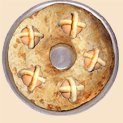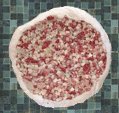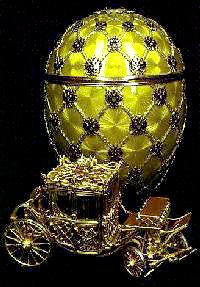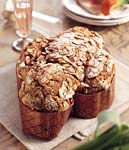
Raffaella’s father is from San Daniele del Friuli, known as the home of the best prosciutto crudo. Friuli is the northeastern portion of Italy with influences from both Austria and the Slavic countries. Fruili also has some fantastic wines, including my favorite
Refosco. This is the origin of fantastic women, beautiful, hardworking, realistic, intelligent just like my Raffaella. These are hard working people who live in a hard land. Highly seismic, mountains, hills, rocky soil, normal winds that arrive at 100 mph, this area has created some fantastic people, they love their land, their families, their traditions and their wine.
This is the land of coffee made with grappa instead of water and the bianchino, chilled white wine at 7 in the morning. Picolit, the best white grape in the world also is grown in this area. It is also the land of Bacala’, Brovada, and a little known, but fabulous, Easter bread, the Gubana.
Every city, every homemaker, will have the “original” recipe for Gubana and they will differ from town to town however, the origins are widely attributed to Cividale. In 1409 Gubana was listed as part of the menu’ during a dinner sponsored by the city in honor of Pope Gregorio XII. In numerous songs, telling the history of Friuli, the Gubana is mentioned as one of the specialty for celebrations. In many areas, brides will give pieces of Gubana instead of the confetti used in the rest of Italy. Whatever the origin, or the original recipe, this sweet bread will be part of the Easter celebrations.
Ingredients for 2 Gubana
1 cup (130 g.) unbleached all-purpose flour
4 cups (500 g.) unbleached all-purpose flour
1 stick (115 g.) butter at room temperature
3 eggs
8 tablespoons sugar
1 teaspoon vanilla extract
zest of 2 lemons
¼ cup (10 dl.) warm milk
3 tablespoons warm milk
1 ¼ teaspoons salt
3 packages (21 g.) active dry yeast or 100 g. cake yeast
1 tablespoon grappa, cognac or rum
The dough is made in two steps.
Sponge:
Dissolve 1 tablespoon of sugar in the ¼ cup warm milk. Stir in the yeast and allow to sit for 10 minutes. The milk-yeast mixture should be very creamy. Add the yeast-milk to the flour and mix with a spoon. This mixture will be very liquid. Cover with plastic wrap and a towel and let rise for 1 hour.
Dough:
Add the eggs, remaining sugar, 3 tablespoons warm milk, and the grappa to the sponge and stir until smooth. Mix the salt with the flour. Stir in the flour, one cup at a time and keep stirring until smooth. Stir in the lemon zest and vanilla. Finally stir in the butter. Flour your surface generously, flour your hands, and use a dough scraper initially to turn the dough. The dough will be extremely sticky initially. Knead the dough until velvety and supple, at least 10 minutes.
Cover and let rise until doubled. Be patient, this will take at least 3 hours.
Ingredients for the Filling
2 cups (250 g.) crushed walnuts
1/2 cups (50 g.) pine nuts
2 tablespoons butter
1 cup (100 g.) white raisins
1 teaspoon vanilla
1/4 cup candied citron
zest of 1 lemon
1 egg beaten
salt (just enough)
1/2 cup apricot jam
2 oz. of grappa or cognac
1 1/2 tablespoon unsweetened cocoa powder
3 tablespoons of sweet marsala
Preparation Filling:
Place the butter in a skillet or sauté pan. When the butter starts to melt, add the pine nuts. Stir together just until the pine nuts begin to turn yellow. Remove from heat.
Place the remaining ingredients in a large mixing bowl. Add the pine nuts and stir together. Let sit for 5 minutes and taste. Add grappa or cognac to achieve the desired flavor.
 Assembly and second rise:
Assembly and second rise:
Cut the dough in half. Place the dough on a lightly floured and roll into a 18 x 12 inch rectangle. Spread the filling evenly over the two pieces of dough. With the widest edge toward you, roll, from back to front the dough. Pinch the ends to seal the roll. Roll the log into a spiral so it looks like a snail. Place each roll in a well buttered soufle'or baking dish, cover with plastic wrap and let rise for 2 hours.
Baking: Pre-heat the oven to 375 degrees. Brush the top of the rolls with egg white and perforate the roll in several places with a skewer to release the air that may have formed air pockets. Place in the oven and cook for 25 minutes. Reduce the heat to 325 degrees and cook for another 25 minutes until deep golden. Remove from the mold, very carefully, and cool on racks. Allow to cool completely before serving.
 Serving: Cut into slices. In my father-in-law's town Slivowitz would be poured abundantly over the roll, while other areas will use grappa or rum. With or without this final touch this a great end to an evening meal.
Serving: Cut into slices. In my father-in-law's town Slivowitz would be poured abundantly over the roll, while other areas will use grappa or rum. With or without this final touch this a great end to an evening meal.
Wine: Picolit or Verduzzo di Ramandolo
Technorati Tags: Easter Celebrations Food and Wine Bread Friuli Italy
Labels: Easter, Friuli, Gourmet Foods, Holiday Traditions, Italian Bread, Italian Holidays, Italian Recipes
Read the Full Story...
 The Easter celebrations in Italy are very similar to those practiced in the US. The Easter bunny and Easter egg hunts are not present. Instead the olive branch, and the blessing of the home by the local priest occurs at this time of year. The priest will go door to door with two alter boys and bless each house individually, leaving a blessed olive branch to be hung over the door.
The Easter celebrations in Italy are very similar to those practiced in the US. The Easter bunny and Easter egg hunts are not present. Instead the olive branch, and the blessing of the home by the local priest occurs at this time of year. The priest will go door to door with two alter boys and bless each house individually, leaving a blessed olive branch to be hung over the door.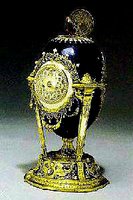 The blessing of the eggs is a widely practiced tradition. The chocolate egg, elaborately decorated, can also be found.
The blessing of the eggs is a widely practiced tradition. The chocolate egg, elaborately decorated, can also be found. Easter is a time of marvelous sweet breads, rich in flavor and symbolism. The Gubana in Friuli, the Casatiello in Naples and the Colomba are all part of this special festivity.
Easter is a time of marvelous sweet breads, rich in flavor and symbolism. The Gubana in Friuli, the Casatiello in Naples and the Colomba are all part of this special festivity. Some areas also have local rituals based on things from their past. In Florence they celebrate the Scoppio del Carro or in Ragusa, Sicily they celebrate the Maronna vasa vasa. No matter where you are Easter is a marvelous occasion to spend time with family and friends.
Some areas also have local rituals based on things from their past. In Florence they celebrate the Scoppio del Carro or in Ragusa, Sicily they celebrate the Maronna vasa vasa. No matter where you are Easter is a marvelous occasion to spend time with family and friends.
